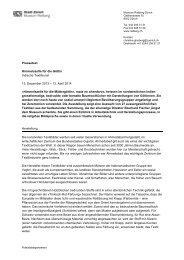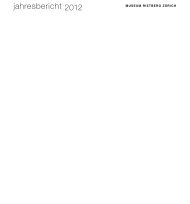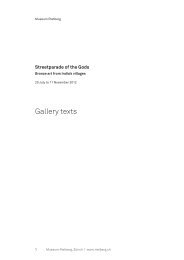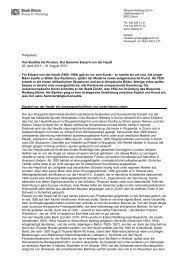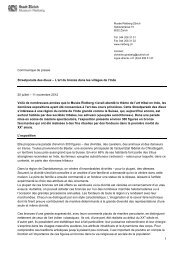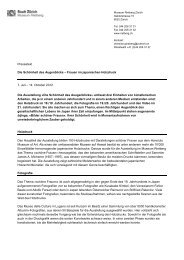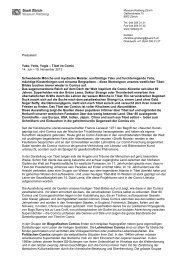1.1 eduard von der heydt - Museum Rietberg
1.1 eduard von der heydt - Museum Rietberg
1.1 eduard von der heydt - Museum Rietberg
Create successful ePaper yourself
Turn your PDF publications into a flip-book with our unique Google optimized e-Paper software.
6.1<br />
die beziehungen<br />
zum kunstgewerbemuseum<br />
<strong>der</strong> stadt zürich<br />
und <strong>der</strong> weg zum<br />
museum rietberg<br />
1932 begann <strong>von</strong> <strong>der</strong> Heydt, seine indische<br />
Bronze- und Steinplastik nach und nach <strong>von</strong> Berlin ins Kunstgewerbemuseum<br />
in Zürich zu transferieren. Denn dort war<br />
Alfred Altherr, ein alter Bekannter <strong>der</strong> Familie <strong>von</strong> <strong>der</strong> Heydt,<br />
als Direktor tätig. Altherr und sein Nachfolger Johannes<br />
Itten (ab 1938) pflegten einen engen, freundschaftlichen Kontakt<br />
mit dem Sammler in Ascona. Sie machten Ausstellungen<br />
mit seinen Leihgaben und produzierten Kataloge, was ganz<br />
in seinem Sinn war. Auch die permanente Präsentation <strong>der</strong><br />
Leihgaben im mo<strong>der</strong>nen, neu errichteten <strong>Museum</strong>sgebäude<br />
(1933) genügte höchsten ästhetischen Ansprüchen.<br />
Mit <strong>der</strong> Ausstellung «Asiatische Kunst aus<br />
Schweizer Sammlungen» in Bern und Zürich setzte man 1941<br />
ein Zeichen, dass man grosses Interesse an <strong>der</strong> Sammlung<br />
Von <strong>der</strong> Heydt hatte und sich ihre Zukunft in <strong>der</strong> Schweiz<br />
wünschte. Seit den 1930er-Jahren gab es Überlegungen, die<br />
Sammlung gesamthaft in Zürich zu zeigen. In <strong>der</strong> 1945 <strong>von</strong><br />
<strong>der</strong> Stadt erworbenen Villa Wesendonck fand man bald darauf<br />
die geeignete Liegenschaft für ein <strong>Museum</strong>. Dass es gelang,<br />
<strong>von</strong> <strong>der</strong> Heydt <strong>von</strong> einer Zürcher Lösung zu überzeugen<br />
und 1949 eine Volksabstimmung zur Gründung des <strong>Museum</strong>s<br />
<strong>Rietberg</strong> zu gewinnen, ist dem grossem Engagement <strong>von</strong><br />
Johannes Itten sowie den Stadtpräsidenten Ernst Nobs,<br />
Adolf Lüchinger und schliesslich Emil Landolt zu verdanken.<br />
Der politische Wille war da, für <strong>von</strong> <strong>der</strong> Heydt einzustehen,<br />
auch als dieser 1948 unter Anklage stand.<br />
6.1<br />
the relationship<br />
to the kunstgewerbemuseum<br />
of<br />
the city of zurich<br />
and the path to<br />
museum rietberg<br />
In 1932, <strong>von</strong> <strong>der</strong> Heydt began gradually to<br />
transfer his Indian bronze and stone sculpture collection from<br />
Berlin to the Kunstgewerbemuseum in Zurich. The director<br />
there was Alfred Altherr, a longstanding acquaintance of the<br />
<strong>von</strong> <strong>der</strong> Heydt family. Altherr and his successor Johannes Itten<br />
(from 1938) were in close cordial contact with the collector<br />
in Ascona. They organised exhibitions with his loans and<br />
produced catalogues, something which he fully supported.<br />
The permanent presentation of the loans in the mo<strong>der</strong>n, newly<br />
erected museum building (1933) also satisfied the highest<br />
aesthetic demands.<br />
With the exhibition “Asian Art from Swiss Collections”<br />
in Berne and Zurich in 1941, a hint was given to <strong>von</strong><br />
<strong>der</strong> Heydt that there was great interest in his collection and<br />
it would be appreciated if its future lay in Switzerland. Since<br />
the 1930s, there had been discussions about showing the<br />
entire collection in Zurich. With the Villa Wesendonck, which<br />
was acquired by the city in 1945, a suitable site for a museum<br />
had been found. That the city council succeeded in persuading<br />
<strong>von</strong> <strong>der</strong> Heydt to make Zurich the home for his collection,<br />
and in winning a referendum about the foundation of <strong>Museum</strong><br />
<strong>Rietberg</strong> in 1949, is due to the great commitment of Johannes<br />
Itten as well as the mayors Ernst Nobs, Adolf Lüchinger and<br />
finally Emil Landolt. The political will was there to stand up<br />
for <strong>von</strong> <strong>der</strong> Heydt even when he was on trial in 1948.<br />
6.1<br />
relations avec<br />
le musée des<br />
arts appliqués de<br />
zurich et<br />
fondation du<br />
musée rietberg<br />
En 1932, Eduard <strong>von</strong> <strong>der</strong> Heydt commence peu<br />
à peu à transférer sa collection de sculptures indiennes en<br />
bronze et en pierre de Berlin au Musée des arts appliqués de<br />
Zurich. En effet, Alfred Altherr, une ancienne connaissance<br />
de la famille <strong>von</strong> <strong>der</strong> Heydt, en était le directeur. Altherr et<br />
son successeur, Johannes Itten (à partir de 1938), entretiendront<br />
une amitié étroite avec le collectionneur d’Ascona. Ils<br />
réaliseront des expositions avec ses prêts et éditeront des<br />
catalogues, à sa grande satisfaction. La présentation permanente<br />
des œuvres dans le bâtiment mo<strong>der</strong>ne de ce musée,<br />
érigé depuis peu (en 1933), répondait en outre à des exigences<br />
esthétiques très élevées.<br />
En organisant l’exposition «Asiatische Kunst<br />
aus Schweizer Sammlungen» (Art asiatique des collections<br />
suisses) à Berne et à Zurich en 1941, les autorités signalaient<br />
leur vif intérêt pour la Collection Von <strong>der</strong> Heydt et leur<br />
souhait de voir celle-ci rester en Suisse à l’avenir. Depuis les<br />
années 1930, on envisageait de présenter l’ensemble de<br />
cette collection à Zurich. On trouva bientôt le bâtiment<br />
approprié pour un musée, à savoir la Villa Wesendonck,<br />
acquise par la ville en 1945. C’est grâce à l’engagement sans<br />
faille de Johannes Itten et des maires successifs, Ernst<br />
Nobs, Adolf Lüchinger, puis Emil Landolt, que l’on réussit à<br />
convaincre <strong>von</strong> <strong>der</strong> Heydt d’accepter une solution zurichoise<br />
et que la création du Musée <strong>Rietberg</strong> fut approuvée par le<br />
peuple en 1949. La volonté politique de soutenir le collectionneur<br />
était manifeste – même s’il avait été mis en examen un<br />
an plus tôt.<br />
Ausstellung <strong>der</strong> Sammlung Von <strong>der</strong> Heydt durch das Kunstgewerbemuseum<br />
<strong>der</strong> Stadt Zürich, 1932, im Landesmuseum in Zürich (exhibition of the<br />
Von <strong>der</strong> Heydt collection in the National <strong>Museum</strong> in Zurich, organised by the<br />
city’s Kunstgewerbemuseum / exposition de la collection <strong>von</strong> <strong>der</strong> Heydt<br />
dans le musée national à Zurich, organisé par le Kunstgewerbemuseum de<br />
la ville de Zurich), (Medien- und Informationszentrum, Zürcher Hochschule<br />
<strong>der</strong> Künste)






